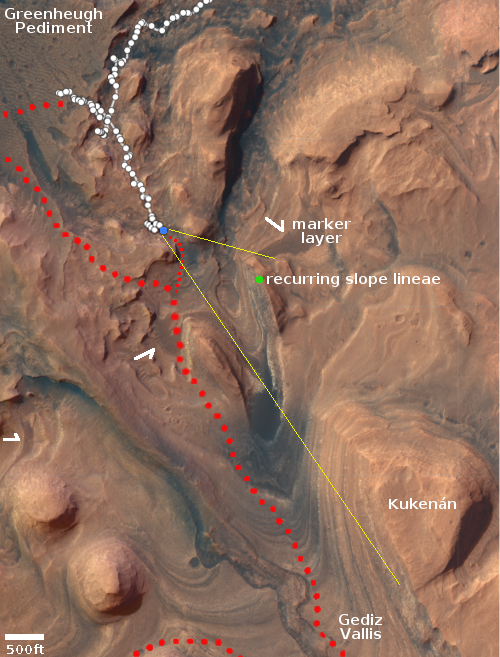Curiosity heads into the pass
Cool image time! The mosaic above, cropped, reduced, and annotated to post here, was created from 31 navigation images taken by the Mars rover Curiosity, and shows the rover’s upcoming drive. From the science team’s July 29, 2022 update:
We are attempting to reach a high point, just at the top right edge of the image, so we can look down into the valley to see if there is a way out on the other side and to help plan our path forward. High tilts, sand, and large and small rocks clutter the terrain, requiring the Rover Planners to pick their way around while making sure they stay clear of the hazards.
After the drive, we took a lot of imaging from our new location, including a 360 degree Mastcam mosaic and an upper tier of imaging to catch the tall relief of the valley walls.
The green dot in the image above as well as the overview map to the right indicates the approximate location on the cliff face of a previously observed recurring slope lineae, streaks that appear to come and go seasonally whose origin is still not understood.
The blue dot on the map marks the rover’s position on August 1, 2022. The yellow lines indicate the approximate area covered by the mosaic above. The large red dots on the overview indicate the rover’s original planned route, with the smaller red dots indicating the hoped-for route to get back to that path.
In the far distance the upper slopes of Mount Sharp can faintly be seen through the winter dust haze. That mountain is about 18,000 feet high, though its actual peak is not yet visible. Curiosity is still about 16,000 feet below that peak. Kukenan is about 1,500 feet high. The cliff with the slope lineae is probably about 400-500 feet high The two side hills that delineate the pass ahead are probably no more than 200 feet high.
Cool image time! The mosaic above, cropped, reduced, and annotated to post here, was created from 31 navigation images taken by the Mars rover Curiosity, and shows the rover’s upcoming drive. From the science team’s July 29, 2022 update:
We are attempting to reach a high point, just at the top right edge of the image, so we can look down into the valley to see if there is a way out on the other side and to help plan our path forward. High tilts, sand, and large and small rocks clutter the terrain, requiring the Rover Planners to pick their way around while making sure they stay clear of the hazards.
After the drive, we took a lot of imaging from our new location, including a 360 degree Mastcam mosaic and an upper tier of imaging to catch the tall relief of the valley walls.
The green dot in the image above as well as the overview map to the right indicates the approximate location on the cliff face of a previously observed recurring slope lineae, streaks that appear to come and go seasonally whose origin is still not understood.
The blue dot on the map marks the rover’s position on August 1, 2022. The yellow lines indicate the approximate area covered by the mosaic above. The large red dots on the overview indicate the rover’s original planned route, with the smaller red dots indicating the hoped-for route to get back to that path.
In the far distance the upper slopes of Mount Sharp can faintly be seen through the winter dust haze. That mountain is about 18,000 feet high, though its actual peak is not yet visible. Curiosity is still about 16,000 feet below that peak. Kukenan is about 1,500 feet high. The cliff with the slope lineae is probably about 400-500 feet high The two side hills that delineate the pass ahead are probably no more than 200 feet high.

















